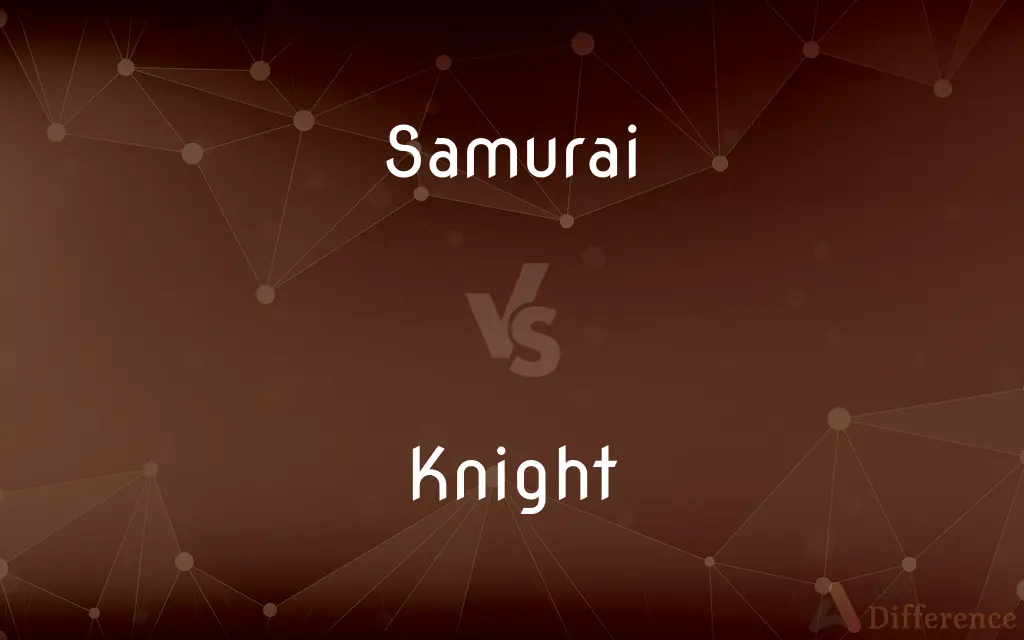Samurai vs. Knight — What's the Difference?
By Tayyaba Rehman & Maham Liaqat — Updated on March 21, 2024
Samurai were elite warriors in feudal Japan, emphasizing honor and discipline, while knights were medieval European warriors, focusing on chivalry and service to a lord.

Difference Between Samurai and Knight
Table of Contents
ADVERTISEMENT
Key Differences
Samurai were the military nobility of medieval and early-modern Japan, known for their strict adherence to the bushido code, which emphasized honor, discipline, and loyalty. On the other hand, knights were European warriors of the medieval period, who followed the code of chivalry, valuing bravery, courtesy, and honor in battle as well as in service to their lord and the church.
While samurai utilized a range of weapons, including the katana, which was revered as the soul of the warrior, knights were often associated with armor-clad horseback riding and jousting, employing weapons like the lance, sword, and shield. This difference underscores the varied martial traditions and warfare styles of the two cultures.
Samurai were part of a highly structured feudal system in Japan, where loyalty to one's lord and clan was paramount, and their status was hereditary. Knights, whereas, could sometimes rise through the ranks based on bravery or service, although knighthood was also often hereditary within the European nobility.
The training of a samurai began in childhood, focusing not only on martial skills but also on literature, calligraphy, and philosophy, aiming to cultivate a well-rounded warrior-scholar. Knights, on the other hand, started their training as pages and squires at a young age, primarily focusing on martial skills, horsemanship, and chivalric values.
The end of the samurai era came with the Meiji Restoration in the 19th century, as Japan modernized and abolished the feudal system. Conversely, the significance of knights dwindled with the advent of gunpowder and changes in military tactics during the Renaissance, leading to a decline in their military importance.
ADVERTISEMENT
Comparison Chart
Origin
Feudal Japan
Medieval Europe
Code
Bushido (honor, discipline, loyalty)
Chivalry (bravery, courtesy, honor)
Weapons
Katana, bow, spear
Lance, sword, shield
Training
From childhood, including martial and arts
From childhood, focused on martial skills
Role in Society
Military nobility, hereditary status
Warriors, often hereditary but could rise
Decline
Meiji Restoration (19th century)
Renaissance (changes in warfare)
Warfare Style
Emphasized personal skill and honor
Focused on heavy armor and horseback combat
Philosophical Study
Integral part of training
Less emphasized
Compare with Definitions
Samurai
The bushido code guided samurai in life and battle, emphasizing honor, discipline, and loyalty.
Even in the face of defeat, the samurai upheld the bushido code.
Knight
A mounted warrior of medieval Europe, bound by the code of chivalry.
The knight jousted in tournaments to display his valor and skill.
Samurai
The era of samurai ended with the Meiji Restoration, which modernized Japan and dissolved the feudal system.
The Meiji Restoration marked the end of the samurai's role in society.
Knight
Knights were often granted land in exchange for military service to their lord.
The king granted the brave knight an estate as a reward for his service.
Samurai
Samurai wielded the katana, a sword that symbolized their status and spirit.
He meticulously cared for his katana, as it was the soul of the samurai.
Knight
Knights wore heavy armor and carried a shield, sword, and lance for battle.
In full armor, the knight was an imposing figure on the battlefield.
Samurai
A member of the warrior class in feudal Japan, known for their military skill and adherence to the bushido code.
The samurai served his lord with unwavering loyalty and honor.
Knight
The rise of gunpowder and changes in military tactics led to the decline of knights.
With the advent of gunpowder, the era of the armored knight came to an end.
Samurai
Samurai also practiced arts like calligraphy and tea ceremony, reflecting their cultured side.
Aside from his martial prowess, the samurai was skilled in calligraphy.
Knight
The code of chivalry dictated a knight's behavior, emphasizing bravery, courtesy, and honor.
He lived by the code of chivalry, showing kindness and respect to all.
Samurai
Samurai (侍) were the hereditary military nobility and officer caste of medieval and early-modern Japan from the late 12th century to their abolition in 1876. They were the well-paid retainers of the daimyo (the great feudal landholders).
Knight
A knight is a person granted an honorary title of knighthood by a head of state (including the pope) or representative for service to the monarch, the church or the country, especially in a military capacity.Knighthood finds origins in the Greek hippeis and hoplite (ἱππεῖς) and Roman eques and centurion of classical antiquity.In the Early Middle Ages in Europe, knighthood was conferred upon mounted warriors. During the High Middle Ages, knighthood was considered a class of lower nobility.
Samurai
The Japanese feudal military aristocracy.
Knight
A medieval tenant giving military service as a mounted man-at-arms to a feudal landholder.
Samurai
A professional warrior belonging to this class.
Knight
A medieval gentleman-soldier, usually high-born, raised by a sovereign to privileged military status after training as a page and squire.
Samurai
In feudal Japan, a soldier who served a daimyo.
Knight
A man holding a nonhereditary title conferred by a sovereign in recognition of personal merit or service to the country.
Samurai
A Japanese warrior who was a member of the feudal military aristocracy
Knight
A man belonging to an order or brotherhood.
Samurai
Feudal Japanese military aristocracy
Knight
A defender, champion, or zealous upholder of a cause or principle.
Knight
The devoted champion of a lady.
Knight
Abbr. Kt or N(Games) A chess piece, usually in the shape of a horse's head, that can be moved two squares along a rank and one along a file or two squares along a file and one along a rank. The knight is the only piece that can jump other pieces to land on an open square.
Knight
To raise (a person) to knighthood.
Knight
(historical) A young servant or follower; a trained military attendant in service of a lord.
Knight
(historical) A minor nobleman with an honourable military rank who had served as a page and squire.
Knight
(by extension) An armored and mounted warrior of the Middle Ages.
King Arthur and the Knights of the Round Table
Knight
A person obliged to provide knight service in exchange for maintenance of an estate held in knight's fee.
Knight
(modern) A person on whom a knighthood has been conferred by a monarch.
Knight
(literary) A brave, chivalrous and honorable man devoted to a noble cause or love interest.
Knight
(chess) A chess piece, often in the shape of a horse's head, that is moved two squares in one direction and one at right angles to that direction in a single move, leaping over any intervening pieces.
Knight
A playing card bearing the figure of a knight; the knave or jack.
Knight
(entomology) Any of various nymphalid butterflies of the genus Ypthima.
Knight
(modern) Any mushroom belonging to genus Tricholoma.
Knight
(transitive) To confer knighthood upon.
The king knighted the young squire.
Knight
To promote (a pawn) to a knight.
Knight
A young servant or follower; a military attendant.
Knight
In feudal times, a man-at-arms serving on horseback and admitted to a certain military rank with special ceremonies, including an oath to protect the distressed, maintain the right, and live a stainless life.
Knights, by their oaths, should right poor ladies' harms.
Knight
A piece used in the game of chess, usually bearing a horse's head.
Knight
A playing card bearing the figure of a knight; the knave or jack.
Knight
To dub or create (one) a knight; - done in England by the sovereign only, who taps the kneeling candidate with a sword, saying: Rise, Sir --.
A soldier, by the honor-giving handOf CŒur-de-Lion knighted in the field.
Knight
Originally a person of noble birth trained to arms and chivalry; today in Great Britain a person honored by the sovereign for personal merit
Knight
A chessman in the shape of a horse's head; can move two squares horizontally and one vertically (or vice versa)
Knight
Raise (someone) to knighthood;
The Beatles were knighted
Common Curiosities
Could someone become a samurai or knight without being born into it?
It was rare but possible, especially for knights, who could sometimes be knighted for valor or service. Samurai status was more strictly hereditary.
How did the weapons of samurai and knights differ?
Samurai wielded weapons like the katana and bow, focusing on agility and precision, while knights used the lance, sword, and shield, relying on heavy armor and brute strength.
What led to the decline of the samurai and knights?
The samurai declined with Japan's modernization and the dismantling of the feudal system during the Meiji Restoration, while knights became obsolete with the rise of gunpowder and new military tactics.
What was the main difference between samurai and knights?
The main difference lies in their cultural origins and the codes they followed: samurai adhered to bushido, emphasizing honor and loyalty, while knights followed the code of chivalry, focusing on bravery and courtesy.
Did samurai and knights serve similar roles in their societies?
Yes, both served as elite warriors who offered military service in exchange for land or status, although their training and cultural practices differed.
Did samurai and knights receive similar training?
Training for both started in childhood but differed in content; samurai received broader education including cultural arts, while knight training focused more on martial skills and chivalry.
Were samurai and knights involved in politics?
Yes, both were deeply involved in their respective feudal systems and often held significant political power or influence.
What role did honor play in the lives of samurai and knights?
Honor was central to both, guiding their actions in battle and society; however, the specific values and behaviors esteemed by each culture were distinct.
How did the societal status of samurai and knights compare?
Both were highly respected and occupied a high social status, but their roles and the ways in which they achieved this status varied due to the different feudal systems.
How did the warfare tactics of samurai and knights differ?
Samurai tactics favored individual skill, precision, and mobility, while knights relied on heavy armor, horseback charges, and formation combat.
What was the role of religion in the lives of samurai and knights?
Religion played a role in both cultures, with Shinto and Buddhism influencing samurai, and Christianity deeply influencing knights, though the integration of religious beliefs into their warrior codes differed.
Share Your Discovery

Previous Comparison
Sidney vs. Sydney
Next Comparison
Flavor vs. TasteAuthor Spotlight
Written by
Tayyaba RehmanTayyaba Rehman is a distinguished writer, currently serving as a primary contributor to askdifference.com. As a researcher in semantics and etymology, Tayyaba's passion for the complexity of languages and their distinctions has found a perfect home on the platform. Tayyaba delves into the intricacies of language, distinguishing between commonly confused words and phrases, thereby providing clarity for readers worldwide.
Co-written by
Maham Liaqat














































